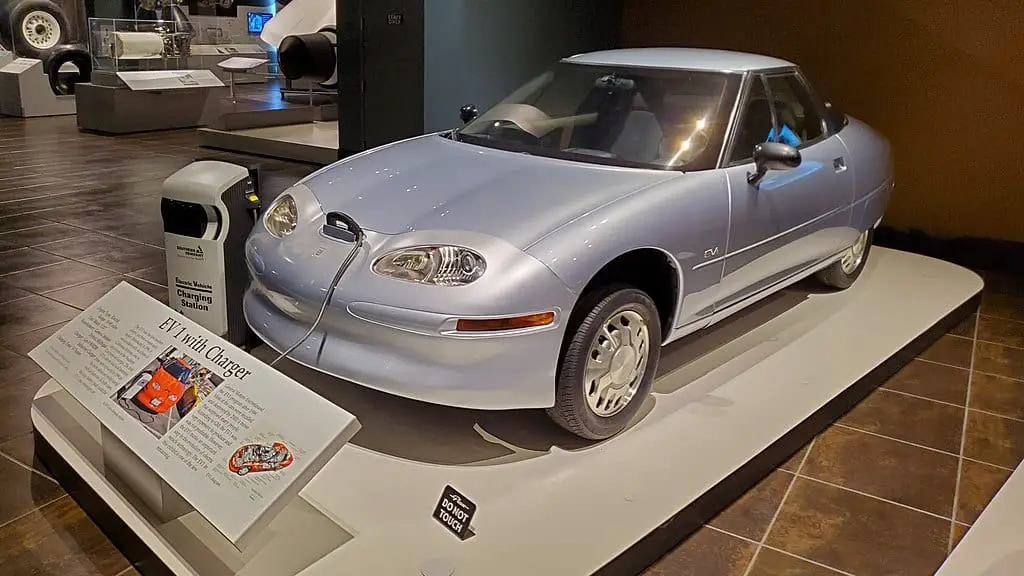If you’ve ever scratched your head over California’s Zero-Emission Vehicle Mandate of 1990, ease assured, we’ve been there too.
This article explores the origin, impact and future considerations of this revolutionary policy that led to battery electric vehicles accounting for 22% of new car sales in California in 2023!
Key Takeaways
- The California Zero-emission Vehicle Mandate of 1990, implemented by the California Air Resources Board (CARB), required a percentage of new vehicle sales to be emission-free, leading to significant advancements in electric vehicle technology.
- The mandate encouraged innovation and spurred the development of impressive electric vehicles like General Motors’ Impact EV, which showcased superior endurance and helped establish battery innovations in electric vehicles.
- The ZEV mandate created emerging opportunities for suppliers in the market who can provide innovative solutions and components for electric vehicles, such as high-performance batteries, cutting-edge electronics, and lightweight materials.
- The future of the ZEV mandate appears promising with increasing global commitment to reducing carbon emissions. Continued advancements in battery capabilities, charging infrastructure, fuel cell technology, and government initiatives indicate that zero-emission vehicles will continue shaping the future of transportation.

Origin And History Of The California ZEV Mandate
The Zero-Emission Vehicle (ZEV) mandate was implemented in September 1990 by the California Air Resources Board (CARB).
The Initial Sales Of Electric Vehicles
In the early stages of the California Zero-Emission Vehicle (ZEV) mandate, electric vehicles experienced a surge in sales. This rise was primarily driven by the stringent requirements set forth by the California Air Resources Board (CARB).
The mandate called for 2% of all new light-duty vehicle sales to be emission-free starting from 1998, a figure that would skyrocket to an ambitious 10% in just five years. Electric cars, with their zero-emission output and promising technology, became ideal options for consumers wanting to meet this regulation while also contributing to environmental efforts.
However, it wasn’t always smooth sailing as policy debates led to necessary adjustments in these initial mandates, underlining the dynamic nature of our pursuit towards sustainable transportation solutions.
Technical Standards Set By The ZEV Mandate
The California Zero-Emission Vehicle Mandate 1990 established technical standards to encourage innovation in battery electric vehicles, fuel cell vehicles, and plug-in hybrid electric vehicles.
These standards have helped shape the evolution of clean transportation.
Encouragement Of Innovation
Driven by the California Zero-Emission Vehicle Mandate of 1990, significant innovations were spurred in the electric vehicle industry. Eager to meet compliance while diversifying their product offerings, automakers harnessed advanced technology and creative design principles to deliver state-of-the-art Zero Emission Vehicles (ZEVs).
Several compelling examples manifested in the market – a clear testament to ingenuity driven by regulation. The lightweight Horlacher Sport EV, capable of covering 340 miles without pausing for recharge, embodied the technological leap achieved with advanced battery technology.
Another impressive feat was Dr. John Dunning’s nonstop journey of 631 miles using an electric Geo Storm; it was indeed an eye-opener for skeptics questioning the viability of ZEVs across long distances on a single charge cycle.
Chrysler seized this opportunity too; showcasing quick-charge capabilities during a national tour that further emphasized how far we had voyaged from conventional refueling cycles associated with gasoline vehicles.
It became increasingly evident that mandates such as CARB’s ZEV program played instrumental roles in fast-tracking fundamental progression within our transportation sector towards cleaner alternatives like Battery Electric Vehicles (BEVs), Fuel Cell Electric Vehicles (FCEVs) and Plug-in Hybrid Electric Vehicles (PHEVs).
Impact Of California’s ZEV Mandate
The ZEV mandate has had a significant impact on the automotive industry, with General Motors making impressive strides in EV production and opportunities for suppliers in emerging markets.

JJonahJackalope, CC BY-SA 4.0 https://creativecommons.org/licenses/by-sa/4.0, via Wikimedia Commons
GM’s Impressive Impact EV
Placing General Motors’ creation under the spotlight, the innovative Impact EV notably altered the landscape of electric vehicles. This trailblazer was a direct response to California’s Zero-Emission Vehicle (ZEV) Mandate in 1990, sparking an electrifying revolution in auto industry advancements.
The vital kickstart provided by this mandate led to GM pioneering various technological features that propelled the Impact EV headlong into widespread recognition.
Car manufacturers worldwide began to take note: there was no putting brakes on battery innovations in electric vehicles any longer!
Emerging Opportunities For Suppliers
As the demand for zero-emission vehicles continues to grow, there are exciting new opportunities emerging for suppliers in the market. With California’s ZEV mandate in place and other states following suit, automakers are under increasing pressure to meet stricter emissions standards.
This has created a need for suppliers who can provide innovative solutions and components for electric vehicles.
Battery companies, for example, play a crucial role in the development of electric vehicles. As lithium-ion batteries become more advanced and affordable, there is a growing opportunity for suppliers to contribute to the production of high-performance batteries with longer ranges.
Additionally, electronics manufacturers have a chance to supply cutting-edge technology that enhances vehicle efficiency and connectivity.
Engineering firms also have an important role to play by developing new charging infrastructure solutions and optimizing vehicle designs for maximum energy efficiency.
Suppliers who can offer lightweight materials or aerodynamic enhancements will be in high demand as automakers seek to improve the range and performance of their electric models.

The Future Of The California ZEV Mandate
Looking ahead, the future of the California ZEV Mandate appears promising. With the increasing global focus on reducing carbon emissions and combating climate change, there is a growing commitment to transitioning towards cleaner transportation alternatives.
The ZEV program in California has not only set an example for other states but also for countries around the world.
The third phase of the ZEV program, which began in 2012, has further accelerated efforts to promote all-electric vehicles by phasing out credits for hybrid electric vehicles.
This move demonstrates a clear commitment to pushing for zero-emission technologies in order to meet ambitious air quality and greenhouse gas reduction goals.
As technology continues to advance at a rapid pace, we can expect significant improvements in battery capabilities and charging infrastructure. Manufacturers are investing heavily in research and development to create more affordable electric vehicles with longer ranges.
Additionally, advancements in fuel cell technology may open up new possibilities for hydrogen fuel cell electric vehicles (FCEVs).
Furthermore, significant California state government initiatives since 1990 such as Governor Newsome’s Executive Order N-79-20 of 2020, reaffirm California’s dedication to achieving its long-term sustainability objectives through programs like Advanced Clean Cars II.
These measures indicate that regulations promoting zero-emission vehicles are here to stay and will continue shaping the future of transportation.
The success of Tesla Model S and Nissan Leaf – among others – confirms that consumer interest in electric vehicles is steadily growing.
The significant increases in electric vehicle sales that are now being reported both within California and nationwide have been made possible thanks to regulatory policies like those imposed by the ZEV Mandate.
Conclusion: The Long-term Effect Of The ZEV Mandate
The California Zero-emission Vehicle Mandate 1990 has had a significant long-term effect on the automotive industry and the environment. By setting technical standards and encouraging innovation, the mandate has paved the way for the development of the electric and fuel cell vehicle market.
It has also created emerging opportunities for suppliers in the electric vehicle market. With Governor Newsom’s Executive Order N-79-20 and the implementation of Advanced Clean Cars II, it is clear that California remains committed to reducing emissions and leading the way in sustainable transportation for years to come.
FAQs
What is the California Zero-emission Vehicle Mandate 1990?
The California Zero-emission Vehicle Mandate 1990 was a regulation implemented by the California Air Resources Board (CARB) that required automobile manufacturers to produce and sell a certain percentage of zero-emission vehicles (ZEVs) in order to reduce greenhouse gas emissions and promote cleaner transportation options.
How did the California Zero-emission Vehicle Mandate impact the automotive industry?
The mandate had a significant impact on the automotive industry as it pushed manufacturers to invest in and develop electric vehicle technology. It spurred innovation, leading to advancements in battery technology, charging infrastructure, and overall electric vehicle performance.
Did all automakers comply with the mandate?
While some automakers initially resisted the mandate, most eventually complied by either producing their own ZEV models or entering into agreements with other manufacturers who were producing ZEVs to obtain credits towards compliance. However, there were legal challenges and modifications made to the original mandate over time.
What were the long-term effects of the California ZEV Mandate 1990?
The long-term effects of the mandate include increased market adoption of electric vehicles not only in California but also globally. The progress made in developing EV technology has led to more affordable options for consumers, expanded charging infrastructure networks, and greater public awareness about sustainable transportation solutions.
Additionally, it has inspired other states and countries to implement similar policies aimed at reducing emissions from gasoline-powered vehicles.
Catchy Title:
1. “How California Led the Green Revolution: The Untold Story of the Zero-Emission Vehicle Mandate”
2. “Unveiling California’s Groundbreaking Move Towards a Greener Future: The 1990 Zero-Emission Vehicle Mandate”
3. “The Secret Behind California’s Clean Air Success: Discovering the Impact of the 1990 Zero-Emission Vehicle Mandate”
4. “From Dream to Reality: How California Pioneered Electric Cars with its 1990 Zero-Emission Vehicle Mandate”
5. “Revolutionizing Transportation for a Sustainable Future: Exploring Californi
Meta Description:
1. Unleash the green revolution! Discover how California’s Zero-emission Vehicle Mandate of 1990 transformed the automotive industry. Get ready to be amazed.
2. Dive into the groundbreaking world of zero-emission vehicles with California’s game-changing mandate. Learn how it shaped the future of transportation.
3. Curious about California’s landmark ZEV mandate? Delve into its origins, impact, and what it means for the future of environmentally friendly cars.
- Tesla Charger Installation Cost (Home Setups) - March 1, 2024
- Tesla Phone Key Disconnected (Troubleshooting Guide and Quick Fixes) - March 1, 2024
- Tesla FSD 12 (Explained) - March 1, 2024